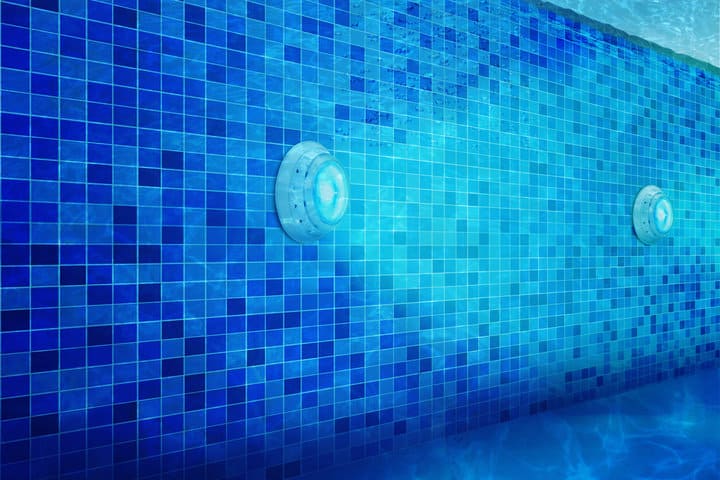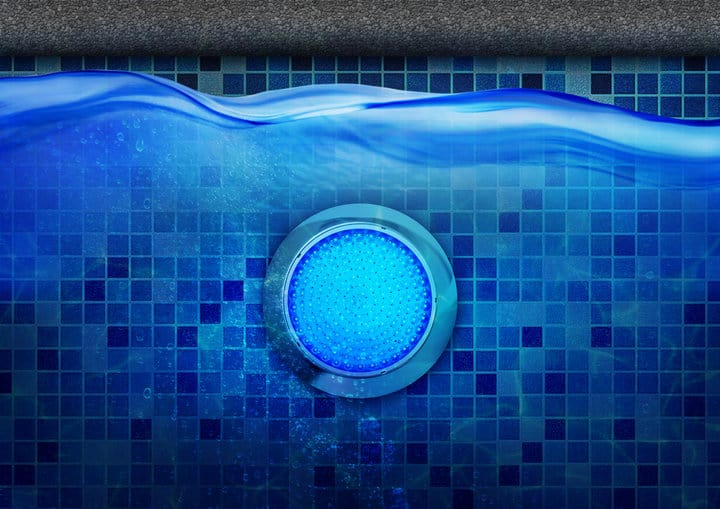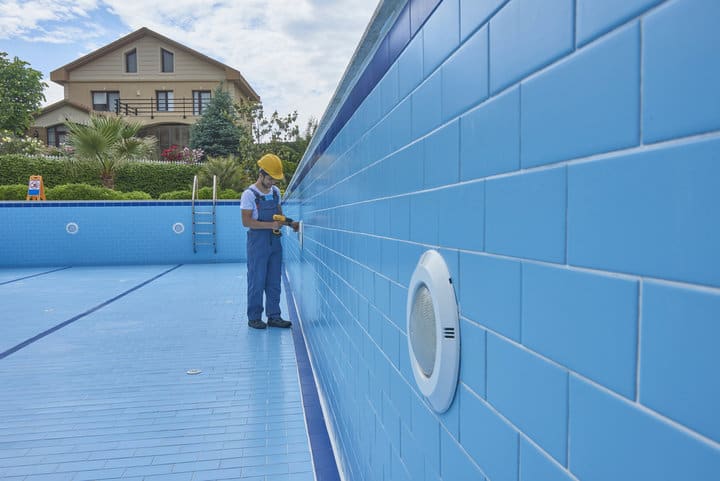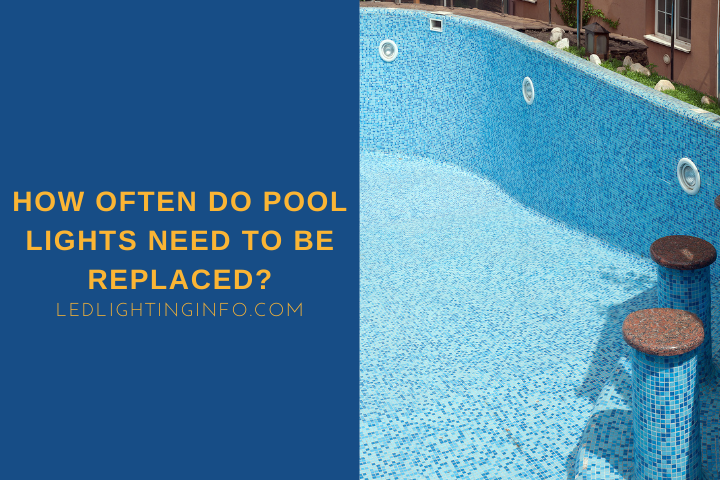Whether you’re installing a brand new swimming pool at home or you’ve owned one for a while (or inherited one with your new home), it’s good to know how long pool lights are expected to last.
Changing lights can be a small job, but it can be tricky if you don’t know what you’re doing.
Understanding how frequently you need to do the job may influence your choice of lights.
Generally, LED pool lights will last at least 20,000 hours, while incandescent ones will last only around 1,000 hours. Halogen bulbs are a little better, averaging 1,500 hours.
Let’s dip into that a little more by looking closely at the following:
- How long you can expect pool lights to last
- How to change pool lights underwater
- Whether you should upgrade to LEDs
How Long Does A Pool Light Last?

The duration of a pool light depends on the bulb type.
It’s the same with any light around your home – the type of bulb and how it operates dictates how long you can expect it to last before it burns out.
Incandescent bulbs are the classical bulb type.
These work through a filament, which has a current passed through it.
The current causes the filament to massively heat up, and as a side effect, this generates light.
Much more energy is used to create heat than light, so they aren’t very efficient.
After a while, the filament will burn out. With pool lights, incandescent bulbs last around 1,000 hours on average.
Halogen bulbs were the next evolution of incandescent bulbs.
They work the same way, except they are sealed within a bulb with halogen gas.
As the tungsten is heated, it evaporates, bonds with the gas then deposits it back onto the filament.
Essentially, it recycles itself.
This process also helps boost the light’s efficiency, meaning they can use less power.
Their lifespan is improved and will likely fall between 1,500 and 2,500 hours, although some say they last up to 5,000 hours.
LEDs are completely different.
No filaments are used – instead, the current passes through semiconductors in the diodes, emitting light.
They use significantly less power, generate less heat, and last much longer – typically at least 20,000 hours. However, some manufacturers may say they last a lot longer than that!
Knowing the number of hours is helpful, but that’s also hard to picture.
So let’s assume you use your pool lights for 5 hours every night.
Here’s how long you can expect your pool lights to last before they need changing:
| Light Type | Lifespan (hours) | Lifespan (days – 5 hrs per day) |
|---|---|---|
| Incandescent | 1,000 | 200 days |
| Halogen | 1,500 | 300 days |
| LED | 20,000 | 4,000 days (11 years) |
Obviously, you might not use your pool lights every night of the year.
Assuming you could use your pool half of the year, you’re changing your incandescent or halogen bulbs roughly every two years.
Meanwhile, your LED bulbs will last for 20 years or more if only used for half the year.
That’s pretty awesome – you can tick off the replacement job for a long time.
How To Change A Pool Light Underwater?

The good news is that you don’t have to drain your pool to do it, regardless of the bulb type and how frequently you have to change the light.
But you don’t do it underwater, either.
Instead, NEC regulations state that the lights must have enough cable hidden in the recess behind them so that you can lift the light out of the water once unscrewed.
To replace a bulb, all you need to do is:
- Switch off the power
- Unscrew the light fixture
- Pull it away from the recess, unwrapping the cord if it is spiraled
- Lift it to the poolside
- Remove the light cover, which is normally held in place by a gasket. You may need to unscrew a bolt, or it may just unclip.
- Unscrew the old bulb, and add the new one
- Check for any wear to the gasket at this stage. Generally, it is a good practice to replace it when you replace the bulb.
- When you seal the light, hold it underwater for a few seconds. If any bubbles are escaping from the light, that’s a sign that it’s weakened and needs to be replaced. Otherwise, it will leak water and damage the light.
- Replace the cover, then put the light back into the recess underwater, carefully tucking the cord away.
- Screw it in with one screw only until you’ve turned on the power and checked it’s working, then add the rest
If you need to replace a sealed LED light, or you want to replace an older fixture with a sealed LED light, that’s a much bigger job that involves feeding the new cable through the existing conduits under the ground.
My guide on replacing pool lights with LEDs covers this in detail.
Should I Replace The Pool Light Bulb With LED?

You might prefer to replace your old pool lights with LEDs for many reasons.
They use less energy for a start – typically around 40 watts per light, compared to about 300 watts for an equivalent halogen or incandescent.
As a quick guide, if you have four pool lights, that’s a difference of 160 watt-hours versus 1,200 watt-hours (or 1.2 kilowatt-hours).
Assuming you used your lights for 1,000 hours, that’s the total energy consumption of 160 kilowatt-hours for LEDs vs. 1200 kilowatt-hours for halogens.
If your typical electricity cost is around $0.14 per kilowatt-hour, your four LEDs are costing you $22.40 for 1,000 hours of use, while halogens are costing $168 for the same amount of time.
Quite the difference!
Then you have the lifespan benefits as covered above. LEDs will last a lot longer, so you don’t need to keep buying bulbs, and there’s less effort involved in replacing them.
LEDs can be brighter, too, if you want a bulb with a higher wattage.
Though you might not – most people prefer pool lights to provide a gentle glow. Hence, the benefit is more about getting the same luminosity from a much lower wattage.
Finally, LEDs are available in more colors.
While you can buy colored halogen or incandescent lights, or colored covers for regular lights, LEDs can be customized in millions of shades.
It makes total sense to use LEDs for a new pool installation. Most people will likely find replacing older lights with LEDs beneficial, too, when you consider all these benefits.
How Much Does it Cost To Replace Pool Lights?
If you’re replacing the light bulb within an existing pool fixture, it is a DIY job, and the only cost involved should be the new bulb.
Expect to pay $10-30 for a halogen bulb if buying new, and $50-70 for an LED light bulb.
That might seem a lot more expensive but remember how many halogen bulbs you need to match the lifespan of one LED.
If you want to replace the entire fixture, you can still do it yourself – it isn’t too tricky. But some people still prefer to hire a professional for peace of mind.
With the work involved in feeding the cable through, expect an electrician to take an average of one hour per light. Of course, it can be done faster, but they’ll be moving carefully.
The average cost of an electrician varies between $40 and $100 an hour, with a call-out fee on top which averages $75.
So to replace one pool light, expect it to cost you somewhere between $115 and $175 without the cost of the lights.
Final Words
If you intend to stick with older pool light technology, you can expect to be replacing bulbs every 2 years or so on average, provided you’re using pool lights for around half the year.
With LEDs, you can expect them to last significantly longer.
There are a host of other benefits too. It makes sense to switch to LED if you want to save money and time.
Have you made the switch to LED yet? Maybe you hired an electrician to do it for you and realized afterward you could’ve saved by doing it yourself?

